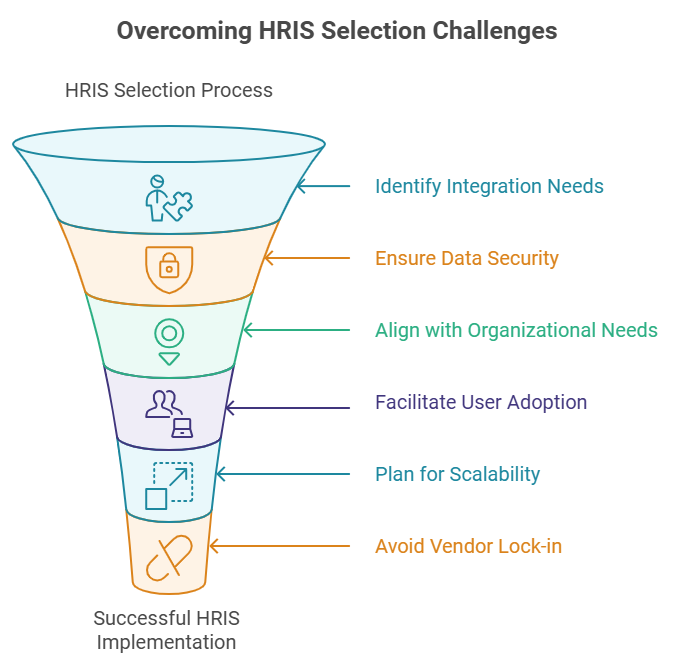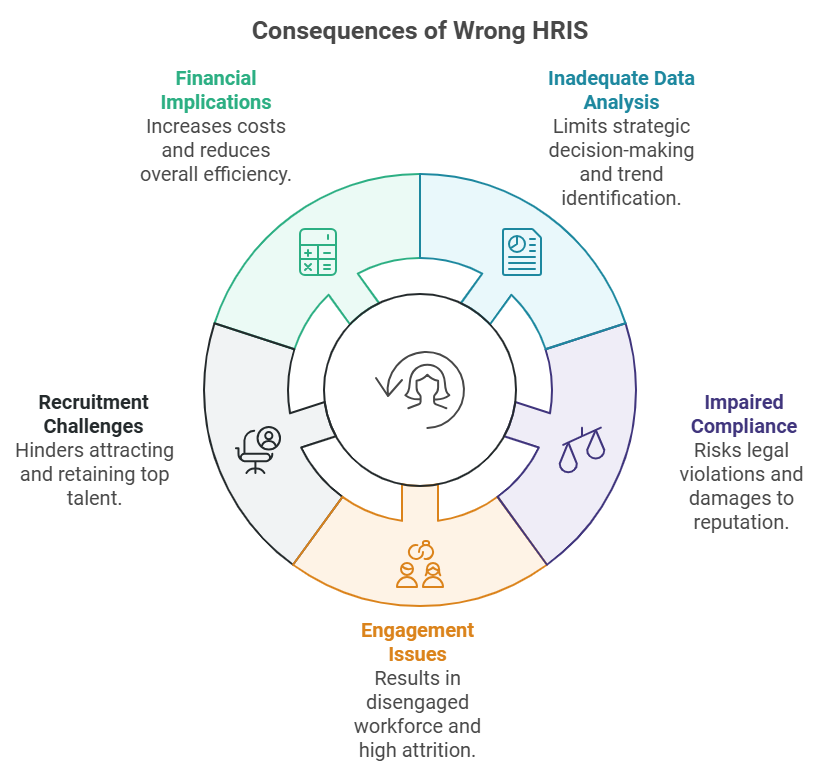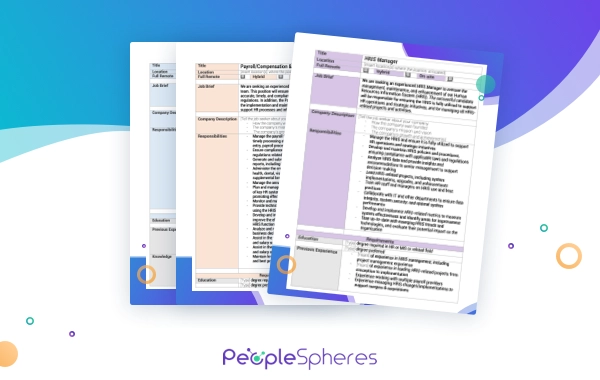
Choosing the perfect Human Resources Information System (HRIS) is a complex and challenging undertaking. It is a decision that can substantially influence the functioning of your HR department and, more broadly, your entire organization. This article aims to explore the inherent challenges involved in HRIS selection, providing you with a comprehensive understanding and guidelines to navigate this process more effectively.
We will delve into various aspects such as understanding your organizational needs, evaluating potential solutions, and considering the implications of implementation and integration.
Related articles:
What is an HRIS? 20 Key Features to Complete your HRIS Experience
Best-Of-Breed vs All-In-One vs EXP: which solution for your HRIS ?
Common Challenges Faced by IT in HRIS Selection
1. Integration hurdles
The new HRIS needs to integrate flawlessly with existing systems within the organization to ensure optimal performance. However, this can pose a significant challenge as systems from different HR vendors may not be compatible with each other. Additionally, the integration process can be time-consuming and expensive. Close collaboration with internal IT services is essential during this stage to ensure compatibility, minimize disruptions, and support a smooth rollout.
To address these integration challenges during the HRIS selection process, organizations often turn to composable HR platforms, which offer a more seamless and cost-effective and modern solution for aligning disparate HR systems. This can even be a cloud-based solution to consider instead of replacing your current systems.
2. Data security and privacy concerns
Given that HRIS manages sensitive employee data, it must adhere to all applicable data protection laws and provide stringent measures against potential security breaches. This poses a challenge as the HRIS must have robust security features to safeguard sensitive information while also being user-friendly and accessible by authorized personnel.
Be thorough in your evaluation. Ask for documentation of security best practices used by your potential vendor. This way, ensuring compliance with ever-changing data protection regulations remains an ongoing commitment for HR professionals throughout the HRIS selection process.
3. Compatibility with organizational needs
Selecting an HRIS that meets all of your requirements can be a daunting task. The software may offer impressive features, but if they do not align with your specific needs, it may lead to inefficiencies and redundant processes. Organizations must carefully assess the potential HRIS solutions to ensure they match their current and future needs. This will allow for efficient HR management and the avoidance of inefficiencies, thus enabling the organization to automate and streamline its HR functions.
You may be asking… what if no HR system meets 100% of my needs?
The answer is that’s it’s completely normal and expected that no vendor will meet 100% of your business needs. What’s more is that even if they meet them today, things may change tomorrow, leaving you with a system that is already outdated.
The idea in this case is to choose a solution that allows you to be as flexible as possible when it comes to HRIS selection. For example, you can use a composable approach, where several systems are integrated and can be switched with ease as your business requirements evolve.
4. User adoption
Even with an ideal HRIS in place, user adoption can be a challenge for organizations. Employees may resist adopting new technology or may not be adequately trained on how to use the system effectively. This can lead to low utilization rates, which can impact the organization’s ability to fully automate HR functions and simplify the employee onboarding process.
To improve utilization rates, successful organizations often ensure they put in place sufficient training and change management strategies. Being available to answer questions and help employees navigate the new system with ease is key. Other organizations use incentives and gamification to motivate employees to use their HR technology.
5. Scalability issues
Especially with large HR vendors, technology can be slow to adapt to new trends and changing needs. For example, the rise of remote work in recent years has brought about new trends like VR training and onboarding which not all HR systems are compatible with. The use of AI is also not yet integrated into all systems. This creates a missed opportunity to increase productivity.
The selected HRIS must not only be flexible but also capable of seamlessly adapting to the changing size and evolving needs of the company. As organizations grow and expand, their HR processes and requirements undergo transformations, and it is crucial for the HRIS to have the capability to easily accommodate these changes. This ensures that the HRIS remains a valuable and effective tool throughout the company’s journey of growth and development.
HRIS solutions should not merely adapt but proactively anticipate organizational growth, allowing companies to scale their workforce and HR functions efficiently and effectively.
6. Potential vendor lock-in
When companies are choosing HR software, it is crucial to consider and carefully evaluate the risks associated with vendor lock-in. Vendor lock-in can potentially restrict future options and create challenges if an organization becomes excessively dependent on a specific vendor.
This dependency might hinder the ability to switch to an alternative system in the future, limiting flexibility and potentially causing complications during the transition process.
Thus, it is essential for companies to thoroughly assess the potential consequences of vendor lock-in before making a decision. Making a well-informed decision during HRIS selection demands a deep understanding of the long-term implications of vendor lock-in, as it can impact an organization’s ability to remain adaptable and responsive to future HR technology advancements and HR management requirements.
7. Transition from legacy systems
The transition from well-established systems to the new HRIS can present noteworthy challenges that require proactive resolution. Employees may encounter difficulties while adapting to the change, and the process of migrating data from the old systems to the new HRIS can be intricate, requiring thorough data analysis and time-consuming efforts to ensure a smooth transition.
It is crucial for organizations to anticipate these challenges and implement comprehensive strategies to ensure a smooth and successful transition. This may involve providing adequate training and support to employees, conducting thorough data analysis and mapping for seamless migration, and establishing clear communication channels to address any concerns or uncertainties.
By addressing these challenges proactively, organizations can navigate the transition with greater efficiency and minimize any potential disruptions to their HR processes. In preparation for the transition from well-established systems to a new HRIS, organizations must proactively anticipate these challenges and implement comprehensive strategies to ensure a smooth and successful migration, which may involve providing adequate training and support to employees, conducting thorough data analysis, and establishing clear communication channels.

The Impact of the Wrong HRIS on an Organization
Choosing the wrong HRIS can lead to employee dissatisfaction due to inefficient HR processes, lost opportunities for automation, and increased IT support demands, ultimately impacting the organization’s ability to streamline workforce management efficiently. An HRIS that’s not user-friendly or fails to meet the organization’s needs can lead to reduced productivity and increased frustration among employees, hampering their ability to automate HR functions and effectively manage workforce resources.
Missed automation opportunities mean that HR and IT teams spend unnecessary time on manual processes, reducing their ability to focus on strategic initiatives.
A faulty HRIS can result in frequent demands for IT support, draining valuable resources and time. This can be detrimental to the overall functioning of the organization and lead to increased costs.
Inadequate Data Analysis
An unsuitable HRIS may lack advanced analytical capabilities, limiting the organization’s ability to make data-driven decisions. Without robust tools for predictive analysis, trend identification, and reporting, HR departments may struggle to track key performance indicators and develop effective strategies.
When it comes to data-driven decision-making, selecting the right HRIS becomes pivotal, as it empowers HR departments with advanced analytical capabilities, enabling precise tracking of key performance indicators and the development of effective strategies based on predictive analysis and trend identification. For example, you can use AI models to predict employee turnover in order to take proactive measures to retain your workforce.
Impaired Compliance Management
A faulty HRIS can impede the company’s ability to stay compliant with labor laws and regulations. If not adequately updated, it can lead to inadvertent violations and subsequent legal implications. Poor compliance management can also affect the company’s reputation.
Employee Engagement and Retention Issues
The choice of a wrong HRIS could lead to problems in managing employee engagement and retention strategies. If the system fails to provide an efficient self-service portal, streamline communication or manage employee performance effectively, it can result in a disengaged workforce and higher attrition rates.
Negative Effects on Recruitment Process
A deficient HRIS may adversely impact the organization’s recruitment process. A system that does not streamline job postings, candidate tracking, and interview scheduling may lead to inefficiencies and can prevent the company from attracting top talent.
Financial Implications
Lastly, the financial implications of a wrong HRIS cannot be understated. Costs may skyrocket due to increased IT support, additional training needs, manual workaround processes, potential compliance breaches, and lost productivity. Implementing the wrong HRIS is not only an immediate financial burden but also a long-term strategic misstep that can hinder workforce management and lead to persistent inefficiencies in an organization’s human resource management.

A Solution That Simplifies HRIS Selection
PeopleSpheres is a next-generation solution that simplifies the HR information system search process. It is a platform that allows organizations to manage all their HR needs in one place.
PeopleSpheres offers a wide range of features, scalability, and flexibility to ensure seamless integration with existing systems. The platform places a high priority on data security and privacy, ensuring all sensitive employee information is well protected.
By eliminating the common challenges faced during the HRIS selection process, PeopleSpheres allows IT professionals to focus on strategic tasks, thus enhancing overall organizational efficiency.
Don’t let the challenges of HRIS selection hold you back. With PeopleSpheres, you can streamline your HR processes, enhance security, and foster a productive and engaged workforce. It’s time to take a strategic step towards comprehensive and efficient HR management. Contact us today to schedule a demo and learn more about how PeopleSpheres can transform your HR operations.




